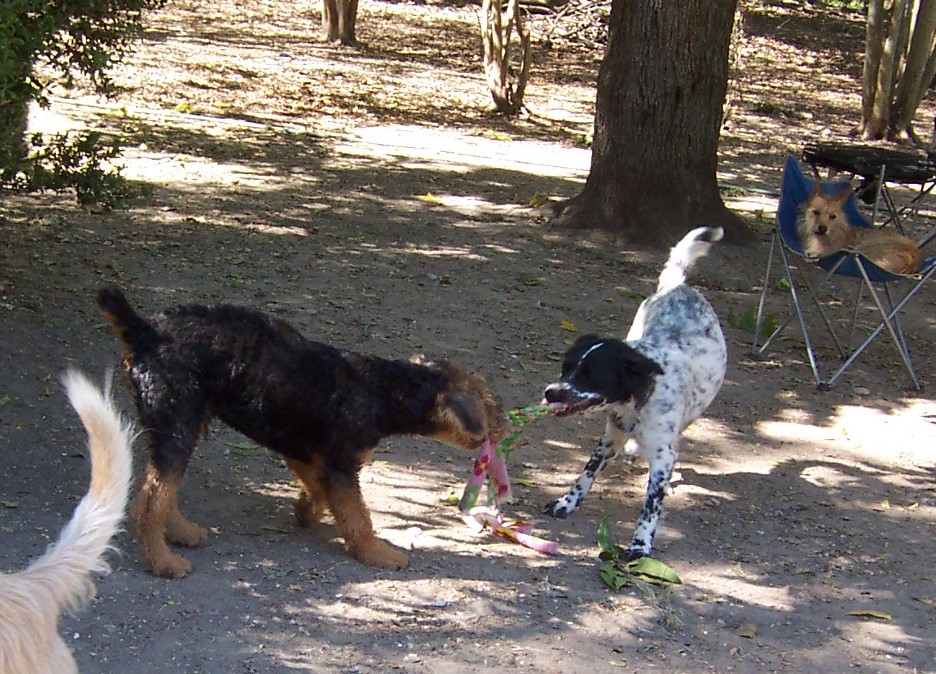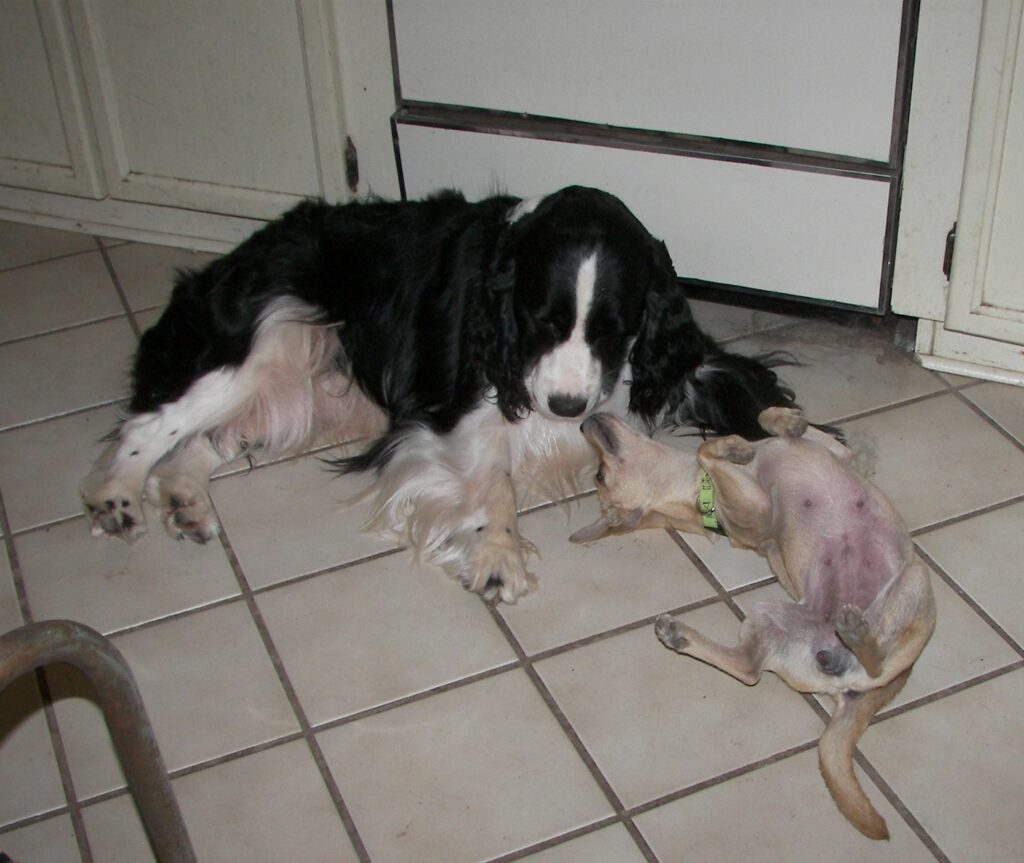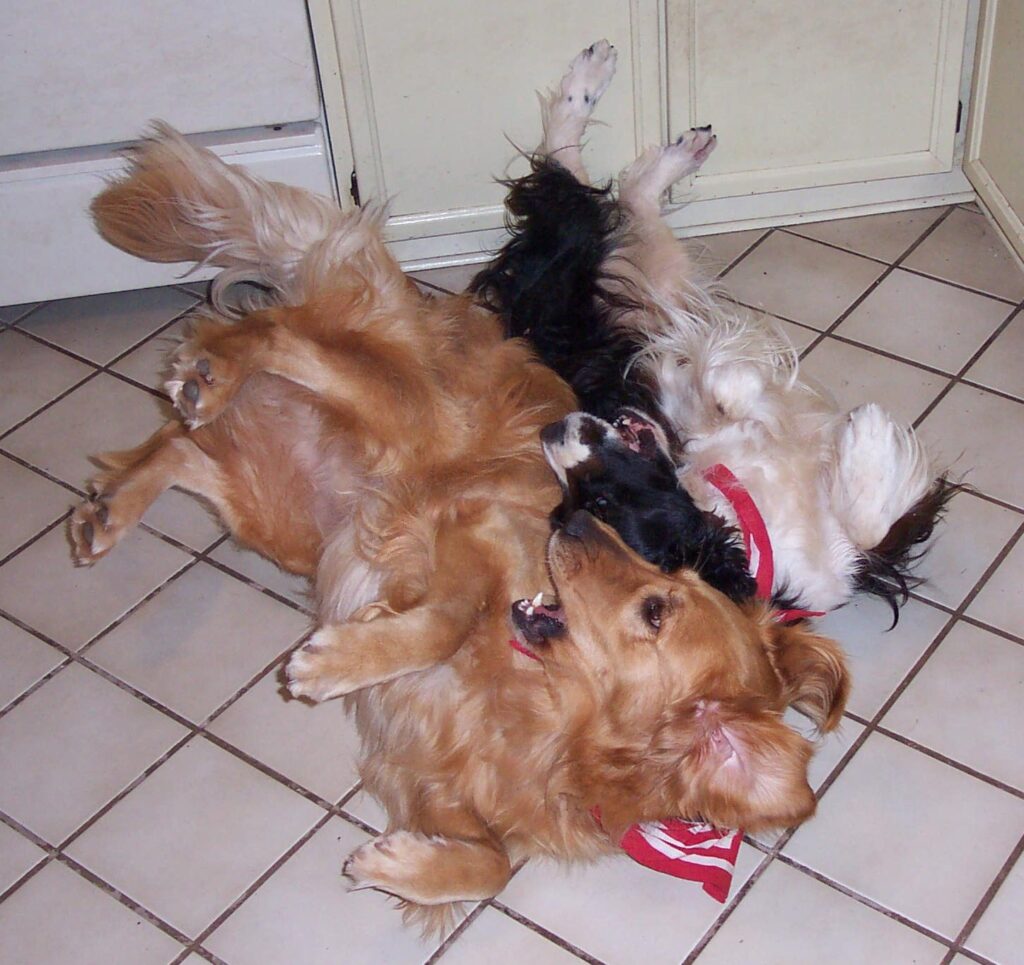This is a really long blog post! Here’s why. The article is not just some fun ideas about introducing dogs. It’s a full self-study lesson in how to do it. Introducing dogs is a big topic, with lots of opportunities to make mistakes that have great impact on dogs’ futures. If you want to learn to facilitate great dog introductions, read it all, click on the links, study the resources, take it very seriously, and build your observation and dog handling skills. That’s what will help you succeed in great dog play-dates, fostering experiences, or living with more than one dog.
There are many reasons to introduce dogs, including:
- A play date
- Fostering a dog
- Permanent living arrangements for a new canine family member
Like people, dogs don’t automatically like every individual they meet. Introductions must be carried out carefully to create the best environment for dogs to feel comfortable enough to get to know each other, play together, and when needed, live happily together for years.
Introduction: a process of discovery
The point of an introduction process is not just to follow the prescribed steps. The goal is to set up controlled situations so the dogs can gather information about each other at a distance where they both feel safe and comfortable. Each situation, including parallel walking, vertical walking, and meeting through a see-through fence, is meant for gradual exposure. The situations are also meant for you to “ask” the dogs how they’re feeling and if they’re interested in taking another step. Read their body language. Let the dogs “tell” you their answers. If they are comfortable, relaxed, curious, and showing interest in continuing the process, take the next step. If not, stop. Take a break and start again later. Email [email protected] to receive our Dog Reading Online Course; it’s a comprehensive class in learning to read what dogs are telling you about how they feel.

Don’t continue if the dogs say no
A play date should be pleasant for all participants. If so, the dogs are likely to want to play together again next time. If the dogs are to live together, they need to be relaxed and comfortable in their home. At a minimum, a single bad experience during introduction stalls the process by creating stress the dogs need time to get over. Bad experiences involving other dogs can have great impact, extending to all dog-to-dog interactions, which can be a challenging problem to solve. It may be very hard to stop the introduction process because you may have your eyes on the “prize” of harmonious play or co-habitation. But if you don’t stop when the dogs let you know they’re uncomfortable, you may have a fight on your hands and you may ruin your chances of the dogs being friends for a long time, if not forever.

Focus on training, not “testing”
Avoid “testing” dogs to “see how they get along with other dogs.” Researchers have not yet been able to come up with a behavior assessment tool that predicts future behavior like some people think these tools do. The protocols for introducing dogs require observation and action on the part of the humans facilitating the introduction. You must make sure the dogs have good experiences. When you do, you are conditioning the dogs to be always better at interacting with other dogs. Teaching the dogs through successful interactions is much better than “testing” to see what will happen.
Don’t let bad stuff happen
It is a major challenge to modify behavior created when dogs have bad experiences with each other. It often only takes a single event to cause a dog to be defensive the next time he meets another dog. A dog who behaves inappropriately with other dogs may cause grief in his household by requiring additional supervision, management, and training by his owners, often taking months or years and requiring the help of a dog behavior professional at great cost. If the dog in question is a foster dog, he is immediately less adoptable, requiring a special home that can provide the management and training he needs. Proceeding carefully, allowing the dogs to explore and be curious, and making it OK for them to choose whether to interact or not, prevents problems that could haunt you and the dogs for life.

Start with calm dogs
Dogs that are already showing signs of stress/anxiety are not ready to meet other dogs. Though they may be excited and want to play, their play is not likely to be acceptable to other dogs. Take your time and try to get the dogs to relax before any introductions. If they just can’t, you’ll need to wait until another day. Spend time reducing stress with food puzzles, walks, running in the yard without other dogs around, playing gently with you. Make sure the stressed dog gets plenty of quality sleep and keep the stressors away until he can relax. Then ask him if he’d like to meet another dog. You’ll have a much greater chance of a friendship between the dogs.
Environment shouldn’t add stress
Any outdoor area other than your own yard is likely to be a neutral area for both dogs, removing the possibility of a dog behaving as though he “owns” the place and thus bringing an additional stressor into play. Some dogs will very quickly “take possession” of any area, so pay attention for signs and don’t try introductions if this is going on. Guarding areas can be a stress-induced behavior, so as always, keep the number of stressors at a minimum to reduce chances of this behavior.
Just one small change at a time
Remember: each of these suggested procedures is merely a way to set up a situation in which to “ask” the dogs how they’re feeling. Assess their comfort level often, with every change in the environment. Changes in the environment might be: another dog coming into view, that dog coming a little closer, a car driving by, a squirrel, or another human walking up. Each change adds one more distraction and dogs can only process a few things at a time.
Parallel walking
Parallel walking is taking the dogs on a short leash walk together, at a distance from each other where they are both completely comfortable. This may mean on opposite sides of the street or twenty feet apart in a parking lot. Provide plenty of space. Watch the dogs – they’ll “tell” you how much space they need by their level of relaxation and curiosity. Email [email protected] to receive our Dog Reading Online Course; it’s a comprehensive class in learning to read what dogs are telling you about how they feel.
Vertical walking
To set up a vertical walk, have the dogs take turns following each other. The dogs will encounter each other’s odor as they walk. Continue to give them as much space as they need to be comfortable, but allow the following dog to sniff the leading dog as they walk – as long as both are calm and show interest. Both dogs have to volunteer for any interaction. After only 2 – 5 seconds of sniffing, call the dogs away to start walking at a greater distance again. This provides a break for both dogs. (See the section below on Taking Breaks.) Switch places and have the following dog become the leading dog. Again, no pressure from the humans, but if the dogs are interested, let them sniff. Facilitate good interactions, observe behavior, and limit the length of interactions at this point.
No pressure!
Take the pressure off yourself and the dogs. Of course, you have a goal for the dogs to like each other – otherwise you wouldn’t be doing all this! Set that aside for now and remind yourself that you’ll probably succeed over time, but you can’t rush the dogs. Allow the dogs to sniff each other briefly when they show interest, but focus on the walk. Take the attitude that you are simply going for a walk and you don’t care whether these two dogs like each other or not. This approach will help you keep the pressure off the dogs. Also, when your dog is on leash, walking with you should be the first priority, so this is a good learning opportunity. Seeing other dogs on leash is different from playtime off leash. You’re training other behaviors besides appropriate interactions.
Treats are training tools
Give the dogs treats when they look at you and when they’re walking nicely with you. Treats help make a good association with the presence of the other dog and condition the happy emotional responses you want. This process will go a long way toward preventing leash reactivity toward other dogs, which is all too common. You’ll prevent dogs from becoming aroused and allow them to “introduce themselves” with no pressure while they’re having a good time. Only move closer if the dogs are calm, “asking” to move closer, and you are sure they are ready.
When the dogs are close together, don’t use treats – at that point food can cause stress due to competition and conflict. Use treats when it’s just a human and a dog walking together with another dog nearby. Stop the treats when the dogs are investigating each other at close range, and use treats when you’re walking again, at a distance from the other dog.
Read what the dogs are “saying”
Even if the dogs look like they don’t even notice each other, be assured they do. They are most likely glancing at each other off and on as they walk, though you may not see it. You may notice “Calming Signals” between the dogs. They may turn their heads away from each other or sniff the ground as they walk. Dogs share these signals as a way to let each other know they mean no harm or threat. Click here for more information on Calming Signals from trainer Turid Rugaas.
Watch for stress signals
It is natural for dogs to be a bit stressed during a new experience, so you may see lip licking, yawning, or tense ears or tail. You may see a dog “shake himself off” as though he just had a bath. Make sure these signs are decreasing in frequency during the walk – they are your indicators of whether a dog is comfortable or not. Loose, wiggly bodies, softly wagging tails, relaxed faces, and perhaps some friendly gestures like bouncy movements or a little play bow are signs of relaxation and comfort with the situation.
The terms “stress signals” and “calming signals” can be confusing. Don’t worry too much about analyzing each one. What you want to see is dogs showing relaxed body language, curiosity, and clear gestures of interest in play while giving each other space. Head turns and ground sniffing are clear, polite communications. Lip licking, yawning, stiff bodies, tense faces, jerky movements, or shaking off are signs the dogs are uncomfortable with the situation and need a break.
Slow down and take breaks
Allow both dogs to relax, explore the other dog from a distance and only briefly from up close. When both dogs seem relaxed and comfortable and each has had a chance to sniff the other a few times, take a break and separate the dogs before setting up another situation in which to ask them how they’re feeling about the other dog. Maybe they need a drink or a roll in the grass to reduce stress. Maybe they just need to lie down and process the information they’ve received.
Use a see-through fence to introduce dogs
A chainlink or other see-through fence separating adjacent yards is a great way to introduce dogs. They can see each other’s body language, they’re free to respond as they see fit, and they can move away when they want to, all off-leash. Being off-leash gives dogs better opportunities for expressing themselves. Leashes get in the way of their body language and require intense management from the human handlers. If necessary, leave leashes attached but drop them to give dogs more freedom.
Let dogs experiment; keep it short
Each dog should have a handler in the yard with him, in case he needs a break. Allow each dog to be curious and cautious as he chooses, use his body language, sniff to learn about the other dog, offer play behaviors, or use calming signals as he chooses. Your job is to facilitate brief, happy interactions. Provide lots of breaks by calling the dogs away from the fence for a moment with the handlers. Don’t let them spend more than about 15 seconds at the fence together at this point. They might even limit their own interactions and give each other space, which is perfect! Observe both dogs for signs of curiosity and playfulness toward each other.
Fences are useful, even on leash
If you don’t have two adjacent secure yards, you can compromise by having the dogs on leashes. Perhaps you can have them on either side of a chain-link fence for safety, even if the areas are not secure enough to have the dogs off leash. Baseball fields and dog parks can work well for this, with one dog and human inside the fence and one dog/human pair outside the fence. If there’s a fence between the two dogs, the humans may feel more secure and be able to focus on keeping the leashes loose.
Leashes must be loose
Loose leashes are important. Don’t let a dog associate a tight leash pulling on his neck with the presence of another dog. The goal is for each dog to associate the presence of another dog with only good things. When introducing dogs on leashes, the humans must be careful to move in toward the dogs to keep the leashes loose. Handlers must also move around to keep the leashes from becoming tangled. Tangling can result in you not being able to separate the dogs if one or both of them becomes aroused or stressed, causing a fight. Gently walk dogs away from the fence to reward them for interacting well; walk them away for a break if you accidentally allow things to get out of hand.
Leash skills and emergency plans
All this takes practice! Practice good leash skills all the time so you’re prepared with tools to keep them loose during introductions. Move toward the dogs as the dog you’re handling moves in, to keep the leash loose. Execute a happy, gentle U-turn by encouraging a dog to turn with you, without pulling on the leash, so you can move him away for a break. If a dog is small, you can pick him up and walk away as needed. Even if a dog is bigger, picking him up to move him away may be a good emergency plan to prevent a bad experience. Your observation skills are one key to successful introductions.
Short interactions, lots of breaks
Assuming you see plenty of curiosity and playful behaviors, allow many short meetings – 30 seconds or so. Call or lead the dogs away from each other for a break, affection, and maybe a treat. You can repeat these little meetings many times, gradually increasing the amount of time the dogs are together at the fence or sniffing each other on their loose leashes.
Don’t “keep going till you fail”
Remember, it’s always better to separate the dogs while things are going great than to try for “just a few more seconds” and have things turn bad for everyone.
Taking breaks
After a brief new experience, give the dogs a break to re-group. Happily walk them away to a quiet spot with a door or gate between the dogs and provide separate water bowls for drinks. Breaks allow relaxation, stress relief, rehydration, and preparation to learn something new. Humans need breaks from intense observation of the dogs. Let dogs lie down and relax if they want, or enjoy a short play session between human and dog if they’re calm and seem to want that.
Assess during the breaks
A break is another time to “ask” the dog questions: how is he doing after the introduction session? Is he calmer or more aroused afterward? Does he seem excited to go back to the other dog, or ready for some alone-time? Dogs are the best judges of what they need during a break, unless they show signs of becoming over-aroused; then you must help them calm. If a dog is over-aroused after an introduction session, you may need to stop for now and start again in a few hours or on another day.
How do we know the dogs are ready to play together?
- Both dogs are relaxed with loose, flexible bodies – no stiffness.
- Both dogs are offering play behaviors
- turning tail while looking back over their shoulders at the other dog
- play bows
- loose, bouncing actions inviting play from the other dog
- tiny bursts of running, inviting the other dog to chase
- Neither dog is showing aroused behaviors like mounting, stiff-legged bouncing, rearing up on back legs, charging or body slamming the other dog
- Each dog is clearly interested in playing with the other dog.
- Both dogs are approaching and retreating from each other.
- Both humans are calm, relaxed, and ready to help the dogs succeed.
When it’s time to let the two dogs play, allow it for a very few minutes and take a break.
In general, signs of a good play session include the following:
- Both dogs are relaxed with loose, flexible bodies – no stiffness.
- Each dog is giving the other dog room, never pinning them down or in a corner, and either dog has an easy escape route to leave the game when he chooses.
- The dogs are taking turns chasing and being chased or being on top when wrestling.
- There may be loud play growls and the dogs may bark at each other.
- The dogs may have their mouths wide open with teeth showing, but they are not biting down on each other, only placing their mouths on each other in a symbolic manner.
Continuing introductions
If dogs are to live together, remember they have separate needs. Each dog needs alone-time and time with their owner all to themselves, as well as time to play together. Don’t expect dogs to be together 24/7. Keep interactions short at first – 5 minutes or so – calling the dogs apart for petting and treats and then allowing further play if they want to. Intersperse separate alone-time, and always supervise the dogs when they’re together. Separate the dogs while they are still having a good time, using lots of praise, treats, and affection. Don’t “keep trying” until things go bad between them. Don’t leave the dogs together when you are away from home until you are willing to bet $100 that they will remain relaxed and friendly with each other the entire time you’re gone. If you’re not sure, don’t risk their relationship.
Plan and take action – don’t “hope”
Spend the time now to resist leaving the dogs together until they are almost “asking” to be together longer. It will pay off later when they have built a great relationship and give each other space as well as cuddle together and play joyously. Don’t try to hurry things, even if the new dog is a temporary visitor. Understand that the dogs have their own ideas about whether to play with other dogs. You can change their minds, but you must do so fairly and with lots of encouragement if you are to succeed. Learn to read the dogs’ communications and respond appropriately to achieve your goals of having them be lifelong friends.

